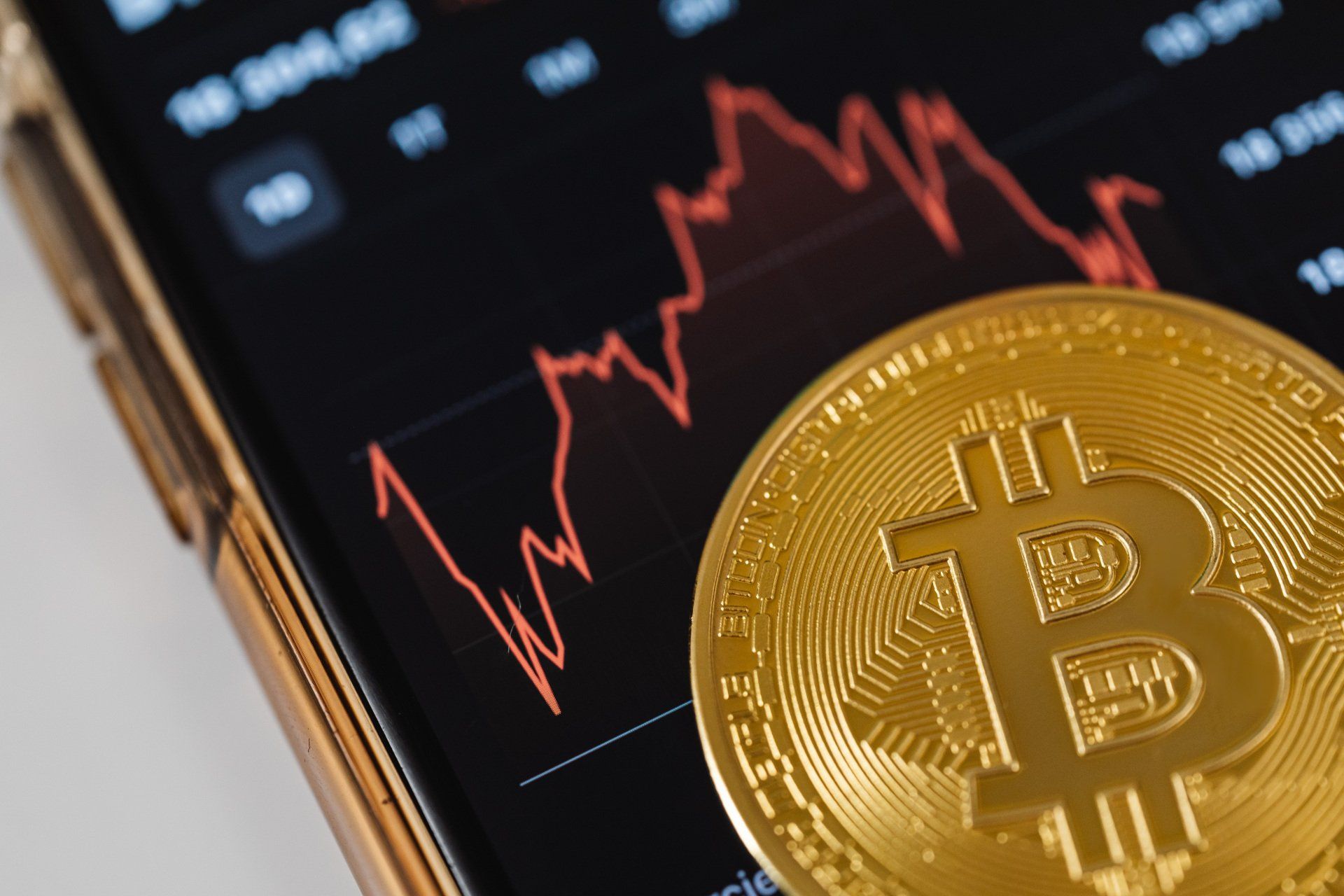Deja Vu?
In 2008, the world was shocked when the housing market seemed to crash overnight. Yet, there were definite indicators back then that a housing crash should have been expected...
Brace for Impact
When the Federal Reserve (Fed) began hiking interest rates at the beginning of 2022, it turned the housing market upside down...Housing economists are waiting with bated breath for anticipated rate cuts to begin...
Bitcoin Boom
On March 5,2024, the cryptocurrency Bitcoin crossed $68,900, the highest price in its 15-year history.This soar comes less than 2 years after Bitcoin dropped below $17,000 in November 2022...What is the cause of this boom?
LATEST NEWS

By Ross Silver
•
09 May, 2024
In March 2024, the average sales price of an existing single family home in the United States was $397,200.00 up 4.7% from March 2023. While prices of homes in the United States may appear to be at an all time high, the total home sales have been decreasing as mortgage rates continue to soar. According to the National Association of Realtors, total home sales in March 2024 were down 4.3% from the previous month and down 2.8% from the previous year. On April 25, 2024, ATTOM, a leading curator of land, property and real estate data, released its first quarter 2024 Home Sales Report. This report showed that the profit margins on median home and condo sales in the United States decreased to 55.3%, down from 57.1% in Q4 2023. Additionally, this report showed that the median home price fell quarterly by 4.3%. According to Freddie Mac, the average interest rate on a 30 year mortgage rose to 7.22%, up from 7.17%, last week. Rising mortgage rates can add hundreds of dollars a month in costs for borrowers. T his results in limiting how much homebuyers can afford at a time when a relatively limited number of homes on the market coupled with heightened competition for the most affordable properties has kept prices marching higher. Additionally, borrow rates on a 15 year mortgage also rose to 6.47%, up from 6.44%. On May 1, 2024, the Fed announced that it does not plan on cutting interest rates until it has greater confidence that price increases are slowly sustainably to its 2% target. Most economists agree that until the Fed cuts interest rates, then mortgage rates are unlikely to ease. With regards to new home starts, 1,458,000 building permits were issued in March 2024, down 4.3% from February, yet up 1.5% from the previous year. Of those 1,458,000 building permits issued, 1,321,000 actually started construction on homes and condos, down 14.7% from February and 4.3% lower from the previous year according to the US Census Bureau. Construction on Multi-family homes (apartment buildings), continued to slow. Construction on buildings with five or more units decreased by 20.7% in March, and was down 43.7% from the previous year. The slowdown in single family housing starts reflects a more cautious outlook in the housing market. Perhaps builders are anticipating that interest rates will likely remain elevated for much longer than previously thought or maybe a large number of homes are still under construction. Either way, it is probably wise to “proceed with caution” when considering the value of investing in a home in the next few months. In 2008, the world was shocked when the housing market seemed to crash overnight. Yet, there were definite indicators back then that a housing crash should have been expected. The biggest indicator was probably the common occurrence of the banks approving individuals for home loans that they simply could not afford; thereby resulting in the nationwide bank failures and bank bailouts by our government. Be on guard. Similar signs exist. High interest rates challenge the affordability of owning a home, and yet, somehow home prices are still high. In March, the consulting firm Klaros Group , released its most recent financial analysis of thousands of banks across the U.S. Of the 4000 banks analyzed, 282 institutions have both high levels of commercial real estate exposure and large unrealized losses from the rate surge. This is a potentially toxic combination for these banks. Housing prices are at an all time high, banks are failing or at the very least, extremely stressed…. This is feeling all too familiar. Tickers to consider: IKT , KALA , CEI , EVAX Sylva Disclaimer: https://www.sylvacap.com/disclaimer

By Ross Silver
•
06 Apr, 2024
When the Federal Reserve (Fed) began hiking interest rates at the beginning of 2022, it turned the housing market upside down. The housing market, more than any other segment of the economy, was negatively impacted as the rate environment changed. Higher mortgage rates initially slowed demand, then dampened housing supply, particularly for those in the market for existing homes. A combination of rising home prices and the highest mortgage rates in more than 20 years, creates a budgeting challenge for potential homebuyers. According to Rob Haworth, Senior Investment Strategy Director at US Wealth Management, “The combination of higher home prices and elevated mortgage rates creates a meaningful headwind for new homebuyers. They either need to be able to make a bigger down payment or they must earmark more of their monthly budget for housing costs.” In December 2023, the Fed's Summary of Economic Projections (SEP), projected three rate cuts in 2024 by the Central Bank. However at the end of March, the Fed's Federal Open Market Committee (FOMC) left the short-term federal funds rate steady at a 23-year high of 5.25% to 5.5% . Interest rate traders are hoping that the FOMC will enact its first quarter cut rate in June. Housing economists are waiting with bated breath for these anticipated rate cuts to begin. Home prices have dropped sharply and appreciation has slowed nationally since the Fed began raising rates in 2022. Since home prices are not solely driven by interest rates, it can be difficult to predict how rate cuts will affect the housing market. Still, the Fed’s policies set the overall tone for mortgage rates. The Fed bumped rates seven times in 2022, a year that saw mortgage rates jump from 3.4 percent in January all the way to 7.12 percent in October. Clare Losey, an economist at the Austin Board of Realtors in Texas, says that such increases diminish purchase affordability, making it more difficult for lower-income and first time buyers to purchase a home. The predicted cuts by the Fed should typically lead to lower mortgage rates. Selma Hepp, Chief Economist at Core Logic stated, “Lower mortgage rates would help spur home sales activity, which are expected to increase in 2024 compared to 2023.” Additionally, Hepp concluded that, “ Declines in mortgage rates will drive more sellers to trade their existing home and help add much-needed inventory to the market, leading to more transactions.” More inventory may lead to more competitive housing prices and reasonable affordability for home buyers. Tickers to consider: IKT , KALA , CEI Sylva Disclaimer: https://www.sylvacap.com/disclaimer

By Ross Silver
•
27 Mar, 2024
On March 5,2024, the cryptocurrency Bitcoin crossed $68,900, the highest price in its 15-year history. This soar comes less than 2 years after Bitcoin dropped below $17,000 in November 2022. Most analysts are very familiar with the volatile cycles of Bitcoin. Immediately after reaching its record high, Bitcoin fell to $61,000 by close of the same day. Today, March 15, 2024, Bitcoin closed at $69,621.28. Bitcoin was originally designed as an alternative to the traditional finance system, in which people might be able to send money around the world without extractive intermediaries. The concept behind Bitcoin allows online payments to be transferred from one party to another without going through a financial institution. Thereby alleviating the typical processing, service and wire transfer fees that are accrued by most financial institutions. Another appealing aspect of Bitcoin is that it has been viewed as an inflation hedge. This means that Bitcoin cannot be devalued by a central bank printing more of it. Bitcoin was designed to only have 21 million units in circulation. In January, the US Financial Regulator approved exchange traded funds (ETF), which has benefited the surging price of Bitcoin since the start of the year. According to Jeff Billingham, director of strategic initiatives at Chainalysis, this approval shows there is now “institutional maturity” in the cryptocurrency market . Additionally, James Knightley, the chief international economist at the banking group ING, says elevated inflation readings have encouraged bitcoin buyers who see the cryptocurrency as an insurance policy against rising prices. According to Knightley, “Risk appetite has also soared in recent weeks with tech stocks fuelling the sense of Fomo [fear of missing out] in markets and I think bitcoin is being swept along in all of this.” Haseeb Qureshi, a managing partner at the crypto venture capital firm Dragonfly, believes that Bitcoin will only continue to increase in value over the next year. Bitcoin has yet to hit the “halving,” a mechanism built into Bitcoin that aims to make the currency more scarce and therefore, more valuable. Bitcoin halvings happen roughly every four years, with the next one set for April. Bitcoin prices rose after each of the three previous halvings, giving reason to believe that the trend will continue. Bitcoin is known for its ability to overcome any challenges and have strong comebacks. Various financial experts have been predicting that the Bitcoin bubble will pop “in the near future” for the past eight or so years; yet, somehow the coin still remains on top. BTC investors are enjoying their high profits and hoping the rising trend of Bitcoin will continue. Tickers to consider: IKT , KALA , CEI Sylva Disclaimer: https://www.sylvacap.com/disclaimer

By Ross Silver
•
17 Feb, 2024
Many analysts and investors adhere to the belief that gold prices and interest rates have an inverse relationship. The idea is that, since higher interest rates make fixed-income investments more attractive, money will flow out of gold and into high-yielding investments as rates rise. Therefore when the Federal Reserve raises the federal funds rate, then weakness in gold should follow. However, historical data shows no significant correlation between rising interest rates and falling gold prices. Ultimately, the relationship between gold prices and interest rates is uncertain and unstable because gold is traded on a global market subject to forces far beyond the reach of the Federal Reserve . From March 2022 to July 2023, the Federal Reserve raised the federal funds rate by more than five percentage points. In that same time period, gold prices rose from $1908.30 to $1960.40. By the end of 2023, gold was trading at $2062.40. While interest rates may have some effect on gold prices, rising rates don’t automatically drag gold prices down . The real picture involves many moving parts, including factors such as fears of inflation, geopolitics, global growth prospects, and wider investor outlooks. It is also important to remember that gold is influenced by supply and demand. Higher interest rates may reduce overall investment demand for gold. At the same time, if supplies do fall, then it is possible that the price of gold sustains, or even appreciates. The constant jostling of supply factors can influence the relationship between the gold price and interest rates. Economic and geopolitical uncertainty tend to be positive drivers for gold. Many investors view gold as a safe-haven asset during troubling times due to its ability to remain a reliable store of value. Because of its low correlation with other asset classes, gold can act as insurance during falling markets and times of geopolitical stress. J.P. Morgan research predicts that both gold and silver will have a positive forecast over the course of 2024 and into the first half of 2025. According to the J.P.Morgan, gold prices will peak at $2300/ oz in 2025. T his prediction assumes a Fed cutting cycle initially delivering 125 basis points (bp) of cuts over the second half of 2024, pushing gold prices to new nominal highs. Tickers to consider: IKT , KALA , CEI Sylva Disclaimer: https://www.sylvacap.com/disclaimer

By Ross Silver
•
18 Jan, 2024
2023 was not a good year for potential home buyers. Mortgage rates surged and hit a high of 7.79% in October. On December 13, 2023, policy makers kept the federal funds rate unchanged for a third straight meeting. The federal funds rate is the benchmark interest rate that financial institutions charge for overnight loans. The federal funds rate tends to indirectly influence mortgage rates. Although economists are optimistic that the Federal Reserve is done with its rate-hiking campaign to lower inflation due to the unchanged rate, affordability challenges will probably continue in 2024. Pent-up demand and low inventory will generally bolster prices, and elevated mortgage rates will remain until the Fed implements cuts to the federal funds rate. The US housing market has experienced a significant upswing in home prices over the past few years. However, forecasting the housing market for 2024, there are signs that this trend may be changing. The data from the housing market indicates a potential housing market correction, with home prices stabilizing and, in some regions, even dropping. According to the Central Finance Group, the real estate forecast for next 5 years presents mixed messages. Some experts predict a stable housing market, whereas others foresee a downturn, leading to a real estate crash. In order to better understand the mixed messages, factors that primarily affect the housing market need to be evaluated. First and foremost is the trend in interest rates. Higher rates typically lead to increased mortgage payments. This reduces the affordability of homes for many potential buyers. This scenario can potentially lead to a housing market correction if the rate rising trend continues. Inflation also plays a crucial role in the housing market. High inflation rates cripple the purchasing power of the consumer. This in turn makes it more challenging for individuals to afford new homes. If wages do not keep up with the cost of living, we could end up with a scenario where home price dropping becomes a common phenomenon. Despite these challenges, there does remain a healthy demand for home purchases amongst millennials. This demand could potentially protect the housing market from a severe crash. Additionally, a limited housing supply has been a persistent issue, and it continues to influence housing market predictions 2024. A limited housing supply combined with a high demand from millennials may play a leading role in keeping the housing market from crashing again. Finally, it is important to remember that in order for the demand from the millennials to positively influence the housing market; interest rates must be cut by the Fed. This is the only way these millennials will be able to afford to purchase a home. If interest rates remain high or continue to rise, it will not matter how much of a demand there is. At the end of the day, the demand will not be met simply because it is unaffordable. Tickers to consider: IKT Sylva Disclaimer: https://www.sylvacap.com/disclaimer

By Ross Silver
•
20 Dec, 2023
Bitcoin was created in 2009, by a pseudonymous creator, Satoshi Nakamoto and is the world’s first cryptocurrency. Cryptocurrencies are digital tokens that use technology to facilitate instant payments without the need of a third party. From the beginning, the Bitcoin supply was capped by Nakamoto. The maximum number of coins stipulated to be in existence was 21 million. As of Nov. 12, 2023, there were 19.53 million Bitcoins in existence with 1.46 million left to be mined. However, experts believe that it will take until the year 2140 before the supply cap of 21 million is reached. In 2009, Bitcoin started trading at a price of $0.00099 per coin. On December 12, 2023, Bitcoin was trading at a price in excess of $41,000 per coin. 2023 has been a surprisingly good year for Bitcoin. Since January 1, 2023, Bitcoin has increased by 164%. It has outpaced traditional assets, including gold which has risen 10% and the S&P 500 which has gained 20%. Additionally, according to CoinGecko data, Bitcoin has increased its share of the total crypto currency market by more than 50%. What is fueling this rally by Bitcoin? One of the most important factors is signs that major investment firms are set to get regulatory approval to offer spot bitcoin exchange traded funds (ETF)— a pooled investment security that can be bought and sold like stocks. Federal regulators are expected to give the “go ahead” for several bitcoin ETFs as early as January 2024. Yiannis Giokas is a senior product director at Moody’s Corporation, an American business and financial services company. According to Giokas, the green light from federal regulators for Bitcoin ETF’s could make investing in crypto more accessible to investors. In an interview with MoneyWatch, Giokas states, "As more and more managers venture into the bitcoin spot ETF space, more retail and institutional investors, even the more conservative ones, will feel a higher degree of comfort investing in this space." Asset management giants like BlackRock and Fidelity are among the 13 companies that have submitted applications to the U.S. Securities and Exchange Commission for the multi-billion dollar product. Another important factor is the growing assumption that the Federal Reserve is done hiking its benchmark interest rate and that inflation is receding. When interest rates fall, investors are more likely to pour money into riskier investments such as crypto. Greg Magadini, Director of Derivatives at the crypto data firm, Amberdata, told CBS MoneyWatch, “Lower rates are bullish for Bitcoin.” So what is in store for Bitcoin in 2024? In April 2024, Bitcoin will undergo what is known as halving. This is an event where the rewards for mining Bitcoin transactions are cut in half. This event occurs about every 4 years and cuts the rate at which new Bitcoin supplies enter the market. Past havings have led to huge rallies for Bitcoin, and another massive rally is predicted for 2024. It is important to remember that past performance is no guarantee of future performance. According to the Motley Fool, Bitcoin investors are setting their sights on the $1 Trillion mark. However, they also recommend that investors should not buy Bitcoin unless they plan on holding it for the next 5 to 10 years. Bitcoin is a “long term investment and should be treated as such.” Tickers to consider: IKT Sylva Disclaimer: https://www.sylvacap.com/disclaimer
FEATURED COMPANIES
Enter your email below to receive free content
Thank you for contacting us.
We will get back to you as soon as possible
We will get back to you as soon as possible
Oops, there was an error sending your message.
Please try again later
Please try again later
Copyright © 2022 SylvaCap, All Rights Reserved. - Privacy Policy - Disclaimer


